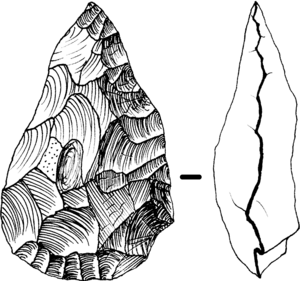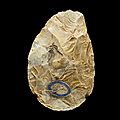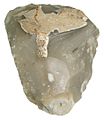Hand axe facts for kids
Quick facts for kids Gray's Inn Lane Hand Axe |
|
|---|---|
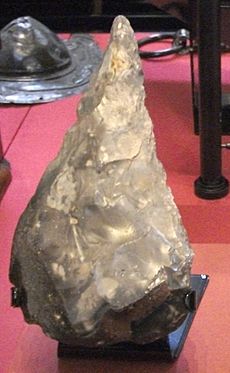
Pointed flint hand axe from Gray's Inn Lane, London
|
|
| Size | 165 mm (6 in) long |
| Created | 350,000 years ago |
| Discovered | Gray's Inn Lane, London |
| Present location | British Museum, London |
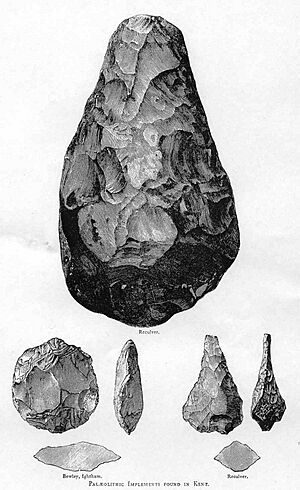
A hand axe is an ancient stone tool used by early humans during the Lower and Middle Paleolithic (Old Stone Age). It was shaped on both sides (called 'bifacial'). Unlike modern axes, it didn't have a handle. People held it directly in their hand, maybe with some leather for a better grip.
This type of axe was very common during the Paleolithic, especially in the Acheulean and Mousterian cultures. It's one of the longest-used tools in human history, used for at least 1.5 million years! Early human species like Homo erectus and Homo neanderthalensis (Neanderthals) relied on them.
Before hand axes, there was an even older culture called Oldowan in Africa. They made simpler stone tools about 2.6 to 1.7 million years ago. We now know that the very first stone tools were probably made by Australopithecines. These tools have been found in the Great Rift Valley of Africa and date back about 3.3 million years.
Archaeologists have found some hand axes in eastern Asia, for example, in Baise, Guangxi, China. However, most tools found there were choppers and flakes, not hand axes. This suggests different tool-making traditions existed around the world.
A line called the Movius Line helps us understand this. It divides the Old World into two parts:
- To the west, hand axes were common.
- To the east, people mostly used choppers or flake tools.
This line suggests there were at least two different cultural traditions for making tools.
Contents
How Hand Axes Were Made

Early hand axes were made by hitting a stone with another stone (called direct percussion). These older axes are usually thicker and have a wavy edge. Later, during the Mousterian period, people used a softer hammer, like a piece of antler or wood. This allowed them to make much thinner, more balanced, and straighter-edged hand axes.
An experienced flintknapper (someone skilled in shaping flint) could make a good hand axe in less than 15 minutes. A simple one could even be made from a beach pebble in under 3 minutes!
Materials Used for Hand Axes
Most hand axes were made from flint. But ancient toolmakers also used other rocks like rhyolites, phonolites, and quartzites. They used whatever suitable rocks were available nearby. Obsidian was rarely used because it's not found everywhere. While obsidian makes a very sharp blade, it breaks more easily than flint.
Different Shapes of Hand Axes
Hand axes came in several basic shapes, such as heart-shaped (cordate), oval, or triangular. Scientists aren't entirely sure why there were different shapes or what each shape meant.
What Hand Axes Were Used For
Hand axes were likely a multi-purpose tool, meaning they were used for many different jobs. Studies of their cutting edges show that they were often used for butchering meat. This included:
- Getting bone marrow out of bones (which explains the pointed end). Bone marrow is rich in protein and vitamins, making it a valuable food source.
- Chopping through bone, muscle, and tendons.
Experiments at Boxgrove quarry support these ideas. For example, a butcher tried to cut up an animal carcass with a hand axe and found it was perfect for reaching the bone marrow.
We know that Neanderthals, at least, were hunters of large animals like mammoths. Other hand axe cultures might have hunted large animals too. This explains why such a heavy and strong tool was needed. Using a hand axe required a lot of strength, and Neanderthals were known to have very strong upper bodies.
Related Pages
Images for kids
-
Flint hand axe found in Winchester
-
Nucleiform biface from the Acheulean site at Torralba, in Soria (Spain). -
Atypical flint biface from the Lower Paleolithic Acheulean site of Kesselt (Belgium), 500.000-390.000 BP Gallo-Roman Museum (Tongeren)
-
Middle Paleolithic flint biface from Meeuwen (Belgium), Gallo-Roman Museum (Tongeren)
-
Flint biface from Saint-Acheul, France.
See also
 In Spanish: Bifaz para niños
In Spanish: Bifaz para niños


